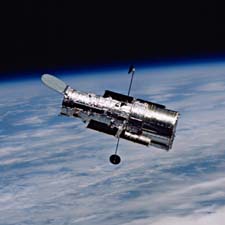
On March 9, 2002, the Hubble Space Telescope was released back into free flight by the astronauts of the shuttle Columbia, who had completed a series of repairs and upgrades over the preceding 5 days.
Courtesy NASA.
The US National Academy of Sciences has assembled a stellar committee of experts to weigh options for extending the life of the Hubble Space Telescope. The panel's roster reads like a Who's Who of luminaries in science, engineering, and space technology. With any luck, the group's deliberations will bring an end to months of rancorous debate about Hubble's future.
NASA administrator Sean O'Keefe kicked off the current controversy in mid-January when, citing safety concerns in the wake of last year's Columbia disaster, he canceled further Hubble servicing missions by Space Shuttle astronauts. Without new gyroscopes to aim the telescope and batteries to keep its electronics warm during orbital night, Hubble will likely stop functioning within three or four years. Astronomers want to keep it going at least through the end of the decade. Widely acknowledged as one of the most scientifically productive instruments ever built, Hubble is especially important as a complement to the Chandra X-ray Observatory and the infrared Spitzer Space Telescope, both of which are expected to last at least that long. Moreover, Hubble's designated successor, the infrared James Webb Space Telescope, won't be ready for launch until 2011 at the earliest.
Hubble was to get new gyroscopes and batteries — as well as two new scientific instruments — during a shuttle visit that was supposed to occur this year but was delayed until 2006 by the Columbia accident. O'Keefe's subsequent cancellation of the flight was met with outrage from astronomers, the public, and the US Congress. In mid-March Senators Christopher "Kit" Bond (R-Missouri) and Barbara Mikulski (D-Maryland), chair and ranking minority member, respectively, of the Senate subcommittee that funds NASA, demanded that NASA seek an independent review of O'Keefe's decision.
The blue-ribbon panel, whose 20 members were named on April 13th, is chaired by Louis Lanzerotti (Bell Laboratories, Lucent Technologies), a senior space scientist and veteran of numerous high-level government advisory boards. Two members have won the Nobel Prize in physics: Riccardo Giacconi (Associated Universities, Inc.), who served as the first director of the Space Telescope Science Institute (STScI), and Joseph H. Taylor Jr. (Princeton University), who co-chaired the most recent "decadal survey" whereby US astronomers prioritized their requests for funding to build new observatories. Other committee members include astronomers, astronauts, aerospace engineers, robotics developers, space-program managers, and risk-analysis experts.
Lanzerotti's panel will look at all conceivable ways to extend Hubble's useful lifetime, including servicing by shuttle astronauts or an advanced robot or simply operating the telescope differently to minimize further wear and tear on its most critical components. The group has also been asked to evaluate the best way to safely dispose of the observatory at the end of its life, and to carefully weigh the risks and benefits of keeping Hubble going in light of the impressive capabilities of modern ground-based telescopes and the expected performance of forthcoming space-based ones. While there's no hard deadline, the panel must complete its work in a matter of months, or else there probably won't be enough time left to implement its recommendations before Hubble succumbs to an equipment failure.
"I am confident that this committee will produce a fair and balanced study," says STScI director Steven Beckwith. "It is an outstanding group of people representing all the important areas that need to be addressed to recommend future action in support of Hubble."
 0
0
Comments
You must be logged in to post a comment.